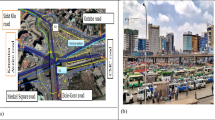Abstract
The dominating source of particles in urban air is road traffic. In terms of number concentration, its main contribution is within the range of ultrafine particles (Dp < 100 nm). The dispersion conditions, i.e. transport and dilution, of the submicrometer particles are expected to be like for gases and therefore the particle concentrations in a street canyon can be calculated using gaseous pollutants dispersion models. Such processes, like coagulation or condensation, are less important due to the short residence time within the street canyon environment.Two extensive measuring campaigns were conducted in the street Jagtvej in Copenhagen, Denmark. The particle size distributions were measured by a Differential Mobility Analyser (DMA) coupled to a particle counter, providing high time resolution data (1/2 hourly) on a continuous basis. Measurements of NOx, CO and meteorological parameters were also available. The measured particle number concentrations, especially below 100 nm, reveal very similar dependence on the meteorological conditions as the NOx concentrations. This underpins the conclusion that dilution properties are similar for particles and NOx. For particle sizes over 100 nm, somewhat different behaviour is observed. This points toward existence of additional particle sources, not related to traffic emissions within the street canyon. A significant contribution is believed here to be attributed to long-range transport. The total particle emission from traffic, including daily variation and size distribution, has been calculated using the OSPM dispersion model. Results are in accordance with a previous analysis based on statistical modelling.
Similar content being viewed by others
References
Berkowicz, R., Palgrem, F., Hertel, O. and Vignati, E.: 1996, ‘Using measurements of air pollution in streets for evaluation of urban air quality-meteorological analysis and model calculations’, Sci. Total. Environ. 189/190, 259–265.
Kittelson, D. B. and Watts, W.: 2000, ‘Nanoparticle Emissions from E.engines’, ‘Nanoparticles: Applications in Material Science and Environmental Science and Engineering’, 6 September, Dublin.
Künzli et al.: 2000, ‘Public-health impact of outdoor and traffic-related air pollution: A European assessment’, The Lancet 356, 2 September.
Vignati, E., Berkowicz, R., Palmgren, F., Lyck, E. and Hummelshøj, P.: 1999, ‘Transformation of size distribution of emitted particles in streets’, The Sci. Total Environ. 235, 37–49.
Wåhlin, P., Palmgren, F. and Van Dingenen, R.: 2001a, ‘Experimental studies of ultrafine particles in streets and the relationship to traffic’, Atmosph. Environ. (in press).
Wåhlin, P., Palgrem, F. and Van Dingenen, R.: 2001b, ‘Source Apportionment and Size Charac-terisation of Aerosol Particles Measured in a Copenhagen Street Canyon’, Third International Conference on Urban Air Quality, 19–23 March 2001, Loutraki, Greece.
Author information
Authors and Affiliations
Corresponding author
Rights and permissions
About this article
Cite this article
Le Bihan, O., Wåhlin, P., Ketzel, M. et al. Application of Dispersion Modelling for Analysis of Particle Pollution Sources in a Street Canyon. Water, Air, & Soil Pollution: Focus 2, 395–404 (2002). https://doi.org/10.1023/A:1021312123848
Issue Date:
DOI: https://doi.org/10.1023/A:1021312123848




